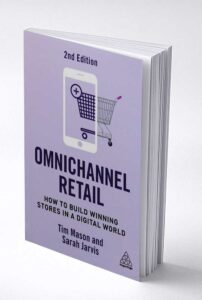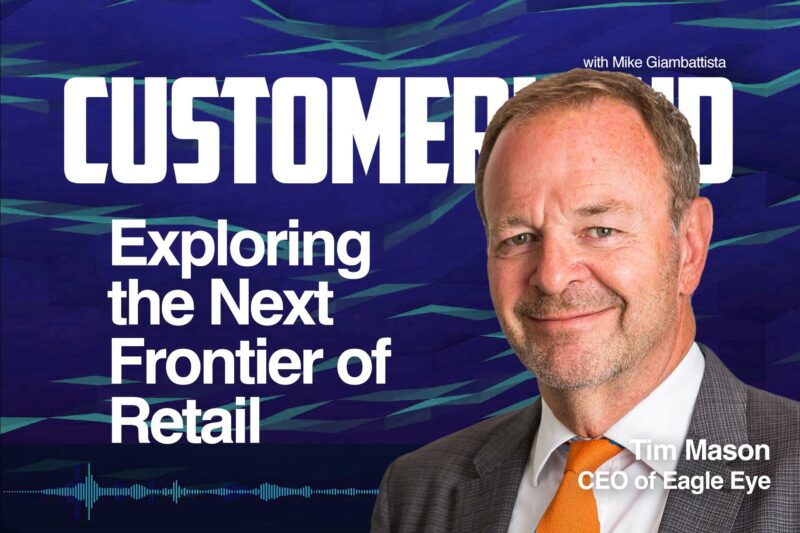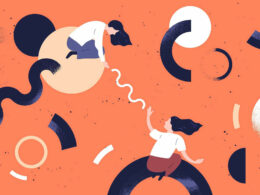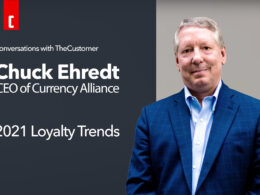Welcome to the world of loyalty marketing, where data drives decisions and personalization is key. In this episode, we’re diving into loyalty programs with Tim Mason, CEO of Eagle Eye and the mastermind behind Tesco’s Club Card—a loyalty program that set a new standard in retail.
Tim’s insights from his journey with Tesco Club Card and the 2nd edition of his seminal book, “Omni Channel Retail,” provide a deep dive into the evolving landscape of marketing. We’ll explore how loyalty strategies have evolved and the growing role of personalization in effective marketing. Our conversation also touches on the impact of AI in reshaping the retail industry, creating tailored experiences for customers.

Looking ahead, we consider the future of retail and marketing. We highlight the importance for businesses to not only predict trends but also embrace new approaches to foster loyalty among customers and employees. We’ll also discuss a timeless business principle that’s particularly relevant in today’s competitive markets.
Get ready for an insightful discussion on the future of loyalty marketing, packed with practical insights to enhance your marketing strategies. Tune in and join us on this informative journey.
Full Transcript Below
Mike Giambattista
Tim Mason is CEO of Eagle Eye. Tim and I have had the chance to talk a couple of times now, I think first was at the most recent NRF event in New York, which was great. I have to claim to being somewhat of an awestruck in fandom by meeting Tim, just because within the loyalty marketing space he’s something of an icon. I’ve certainly tracked his moves for a long, long time. So before we get into all of your background, welcome. Thank you for joining me, Tim, really looking forward to this conversation.
Tim Mason
That’s very kind of you. Thank you very much indeed.
Mike Giambattista
So for those of our listeners who aren’t familiar with Tim, let me give a brief orientation. If you are a UK or have any UK resident, you’re perhaps familiar with Tesco. If you’re familiar with Tesco, perhaps you’re familiar with their loyalty program called the Tesco Card. Tim would not claim to be the architect of that program, yet his fingerprints are all over it. You know, may not have been the original designer, but grew it from an idea into what became, I’m just going to say, the leading loyalty program of its day and groundbreaking in so many ways where organizations looked on and said, hey, look at that. We can actually engage people by new means by deploying one of these programs. So and then, since Tim has gone on to do some great things now CEO of Eagle Eye. So I probably did a terrible justice to your actual work with that introduction. So can you fill in the blanks and make that better?
Tim Mason
Well, yeah, you did, Mike. I mean to be fair, it was not great. So the things actually called the Tesco Club Card, not the Tesco Card, and in fact I would claim to be the architect. It wasn’t my idea it was Terry Lee his idea. But you know, like all great clients, you have this vision and you get hold of your architect and you say I’ve got this vision and I think that’s sort of where I came in, that with a team of people we built, we trialed and then built and then launched the Club Card.
Terry’s view. I mean there are two things behind it. One was he went to university in Manchester, England. The cooperative movement is headquartered in Manchester, England. That’s where he got his first job. And all the way back to their founding, the co-op have this idea of the Divi that you share in the profits of the store that you shop in, and so there was an element of that, I think, that he was keen to really create.
And then the other thing was that Magstripes, computing, computing power. I mean, laughable now when you think about the computing power that is at our disposal now. But computing power meant that you had a chance to start capturing data about your customers and moving the ultimate sort of self-service, anonymized business grocery you’ve got no idea who walks into the door into something that had more of the elements of direct marketing and that’s moved on loads and loads and loads and loads since then. But that was 1995 when we started and there weren’t many people doing it. Well, I think one or two people in the US were probably having early skirmishes, but it was one of the first ones and it did make a big difference. It led to the partnership with Dunn-Humby, which led to what Kroger have done, so very direct influence on the US market from those early days.
Mike Giambattista
Well, it’s quite a leap from getting a directive from your client and then having to build out the plumbing, so to speak, the engineering that would go into building out a program from idea into what became a real substantial program. So, right back at you, I’m giving you some credit back. Thank you, sir, thank you. In 2019, you came out with a book called Omni Channel Retail and that book was really well received in the marketing community broadly, especially in the loyalty community. A lot of people were talking about it. The idea of Omni Channel retail was on everybody’s lips and minds at that point because suddenly, in 2019, we were able to think in those terms and it had been a real challenge up until then. But here we are. What are we?
Three, four years later now, and the world has undergone some tectonic shifts. Customers are no longer acting like they once did, expectations and all that, to wit, Tim has released, or will be releasing, a second edition of Omni Channel retail addressing those changes and where retailers can go. So I’m really looking forward to pulling that apart a little bit, and without giving away the store, because we do want people to buy the book, just talking about what’s in it. So let’s just start with the changes that have occurred in the marketplace since the first edition came out, which was a lifetime ago. What inspired you to write the new one? What was behind it? Was there a certain moment in time, or was there-?
Tim Mason
There was absolutely a moment in time. It was in a meeting with Fair Price in Singapore and there was a French marketing executive in the meeting and we got to the end of the meeting and it had gone pretty well and actually Fair Price did become our first customer for the new business that we were introducing them to at the time of French business we bought called Untimed Knots and Challenges. And this lady suddenly said at the end of the meeting, having not said anything, she said the best thing I have ever been given to do with business is your book. It never leaves my side and I thought and we’ve been mulling over whether we should or shouldn’t do a second edition Was it worth it? And it was on the basis of what she said. I went back to the UK and said we’ve got to do a second edition. If there’s more than one person for whom it really is helpful, then it’s worth doing. So it was that one lady.
Obviously, a lot had changed, as you alluded to in your intro. I mean, we’d been through COVID, we’d been through lockdown, we’d been through the incredible acceleration of e-commerce, the use of digital adoption. Everybody now knew what a QR code was, rather than being that rather irritating thing that you’ve sort of just never worked previously. So the world had been through a real shock and a real change and I think in the time Woolies in Australia, big personalization launch, little unthinkably had launched an app with data capture and giving away rewards as a hard discount. Mcdonald’s were revamped their loyalty scheme we’re putting it on the TV. Asda in the UK broke away from Walmart and very successfully, 25 years on in the UK market launched the loyalty scheme, which is going extremely well, and I think I saw something today that said that as does latest quarterly like for likes of 9% or something Not really.
Walmart plus is Walmart can’t quite jump in the water, but if they can link it to payment and get people to get those benefits and then they can get the data, so they’re going at Tesco. We’ve done Tesco pride club card prices. A lot of things have happened, some of which I’m directly involved in, some of which I’m an observer of which I think were worth commenting on and worth writing about.
That’s the first point. The second point is my job. Really, the reason we wrote the book is my job as a vendor of software that runs loyalty programs is to tell these stories to see sweets around the world. So we’re always evolving and developing the story. So we just said, come on, we better put the new versions of this story in the book.
Mike Giambattista
Get it down on paper, so to speak. Yeah, as you were laying all this out for the second edition, what, in your view, were the biggest changes that needed to be addressed? Is there a lot of them? I mean, the world is not the same world as it was five years ago.
Tim Mason
No, that’s true. I mean, the first thing, which you probably wouldn’t expect me to say, is there are people who know they need to do this stuff, who really don’t get it at all. They’ve never been involved in it, they’ve never worked in it, and so we thought, you know, in terms of 101, we probably ought to go back to what are the fundamentals of a loyalty scheme. Why do you do it, how does it work? What do you want to get? So that was one thing. Now, that wasn’t. I think that was probably prompted by. You would be quite surprised names that you have heard of big, big businesses who actually find that sort of thing really helpful when they’re saying you know, we’re looking at this, what should we be thinking of? So that was the first thing. I think the power of personalization, you know is moving, is definitely moving forward, and so just more about personalization. That is new news.
I have a particular thing about contextual marketing, what I call marketing in the moment. I think one of the most transformational things that we all experienced in pretty recent living memory is Google, near me, searching.
You know, actually, it’s not that long ago that that didn’t exist, and if you think about it, it’s transformed the way that you live your life because of the much greater relevance of the pizza shop that’s near me, the nail bar that’s near me, whatever it happens to be.
My view is that the equivalent of that in marketing is now you know, you’re here, now it’s pouring down with rain, there’s a big college game at the weekend in this city, whatever, whatever, whatever. And as a result of all those things, this is the right thing for you to do at this moment, and so I believe that that will transform marketing, will transform the utility of a digital connection. The first issue of the book talks a lot about trying to make shopping a phone in the hand, not a phone in the purse experience, because if you can activate this personalized digital connection during the shopping process, then you are creating an audience, and an audience with first party data where you can actually measure the impact of your interaction with that audience is unbelievably valuable, and so I think there’s just a huge opportunity here for retailers to to really rethink the way they trade, the way they make profits, the way they expand and develop their businesses, because they just have a. They have a much richer capability to understand consumers than almost any other industry.
Sponsor Announcement
I want to take a quick break from the conversation to tell you about one of our sponsors. What could you achieve if you knew what your customers expected ahead of time? What if you could know what customers expect by category and by brand 12 to 18 months ahead of traditional brand tracking methods? And what if you could know exactly where to adjust and where to spend in order to derive the most benefit every time. A customer expectation audit allows you to identify areas that require strategic reinforcement, as well as pinpoint which values will contribute most to an emotional bond with your brand and optimize accordingly.
Customerland has partnered with Brand Keys, the world’s oldest loyalty focused consumer research firm, to bring real world customer expectation audits to brands, brand managers and to CX practitioners everywhere Want to know where your brand stands and exactly what to do about it.
Go to expectationaudit.com and download a sample audit today.
Mike Giambattista
I’m going to editorialize here just a little bit and say that the themes of personalization have been really popular, with marketers chasing personalization for, I don’t know, 10 years. Is that too long? Maybe seven or eight years in earnest?
Tim Mason
Well, I mean, I would say personally, I’d be doing it longer than that.
Mike Giambattista
For quite a while, whatever that timeline is, and personalization has come to mean a number of things along the way. At first, and this wasn’t that long ago, it simply meant having your name on the message, and now what you’re talking about is something you’re calling a contextual marketing, where all of the factors of the moment are at play to determine messaging, nudging, whatever other behavioral design elements are appropriate at the moment. How are those addressed in the book? Because I think one. I’m just really fascinated by it, but we’re in a moment now that this is all possible. Are there examples of how you would put that out there in the marketplace?
Tim Mason
Yeah, they are all possible. I think I always go back to the old drinking from the fire hydrant. I don’t know whether it’s a metaphor or a simile or whatever. It’s a metaphor Anyhow. Whatever it is, you get the point that trying to deal with supermarket data is like trying to drink from the fire hydrant. Because we started so early, we actually were not able to track what excuse people were buying. So we could track what departments they were shopping in and where they were shopping and who they were and where they lived.
But that taught us two things. It taught us what the spread across departments was of our most loyal customers and what the spread across departments was of least less loyal customers. So then what we started trying to do was to alter the shape of that line to make them look more like most loyal customers, and they were the classic markets.
It was meat, it was wines and spirits, it was health and beauty. These were the markets that tended to be underrepresented by people, who were just a bit less valuable. So what you created was you created a promotional program that’s tried to broaden that out and get them to. And, of course, the fact that they wanted to collect points and earn points meant that if there were new ways to spend, to earn more points, to build more reward, then it was all a virtuous circle and it worked very well. I think that we were saved by starting from there, getting success, learning. It worked. We then got a bit more data. We said, well, what does this extra data tell us? And then we worked from that. This is a very long way of saying.
If you want to know what I would do about contextual marketing, the first thing I would do and this is laid out in the book is I would look at the day that you shop and, rather than sending you all your offers on a Thursday afternoon because that’s when I used to send you the paper flyer I would actually send them to you when you actually shop, because the only thing I know for certain is if you shop on a Wednesday every week, which I’m perfectly capable of telling and knowing. If you shop on a Wednesday every week, the best time to send your offers is not six days before. I don’t know when the best time is to send it to you, but I know it’s not six days before. You can’t be that lucky.
So therefore, I would start targeting when I send the offers on the basis of when my data tells me you’ve got a shop, and look if my data is weak and it doesn’t actually very accurately tell me when you’re going to shop, set it on a bloody Thursday, I don’t care.
But if my data is strong, regular as clockwork, you come in on a Saturday, then send me. Is it Friday night, is it Saturday morning? I don’t know. Find out. That is the first thing that I would do. I believe that that would be really quite beneficial in terms of the utilization of the promotional content that is sent to a consumer. Off the back of that success, you go. Okay, that seemed to work.
What is the next piece of contextual data that we think is likely to influence uptake, enjoyment, satisfaction, lifetime value, you name whatever it is. Then you do that one and if that works, you go. That’s great, okay, and suddenly, in two years’ time, you find that you’re actually looking at two, three, five, seven different contextual elements by this stage, by the way, I think probably having to be handled by AI to make some sort of a trade-off that says, look, if all the context in the world, if it’s going to be, if there’s going to be five foot of snow, that’s the one that matters. So don’t worry about anything else, just dive in on that one. Now, obviously, I pick an extreme example to make my point, but I think that that’s how I would do it. So the honest answer is no. We don’t tell you how to do it in the book, but we do give us suggestion of a place to start.
Mike Giambattista
Your book has a lot of compelling data points and a handful of great case studies, without giving too much away. In your opinion, who’s doing it right and what can others learn from those brands? I asked that knowing, I’m asking you to name names, and if that’s not appropriate then we can.
Tim Mason
No, as you’re in the UK who are a client having a good run Loblaw, I think, consistently and persistently who are a client, have done well. Look, the reason why people pick up, pick the business that I’m CEO of is because we enable personalization, and if so, therefore, the people who lead on personalization are likely to find their way to Eagle Eye’s door, because it’s that you know, we’ve got the data, we know what we want to do. We just can’t execute it. Well, actually, there’s this business that can Woolies in Australia. Similarly Interestingly, woolies in Australia have added a subscription component which and what they’ve done quite bravely is they give you I think it’s 10%. It may have been 20, but I think it’s now 10%. They give you 10% of one shopping trip.
So what they’re encouraging you to do is to have one really big consolidating shopping trip as part of a subscription. You know that’s interesting and I think it’s working. I think Target, who are not a client, have done a great job in terms of lagging as an omnichannel retailer and becoming an omnichannel retailer and really making the store a focal point of delivering the digital experience. So I think they’ve done. They’ve done very well.
Interestingly in the UK, actually, again, sorry, somebody said, somebody said I did one of these ones and somebody said why is it that Tim Mason only ever talks about Eagle Eye?
And sorry about that, but in fairness, obviously I do know a bit more about them other than just being a puff piece.
But President Monge in the UK and I think in the US now have this subscription where for they’ve changed the amounts, but I’m going to say £25 you can basically have four cups coffee a day for a month and then they’ve added a loyalty program on the back of it.
The interesting thing that they’ve done and it’s actually interesting as well that Woolworths have done is you can really build the subscription business, providing you put enough value into the subscription. So there is a very different level of value in free delivery from Amazon than free delivery from a brand that you shop online with sometime never. And so people create these subscription products and then wonder why they’re not terribly successful, and the answer is the consumers, not a chump, and they’re not going to give you their money in advance unless you’re going to make it worth their while. But if you do make it worth their while, they do spot the value and they do take part. So I think that’s a very interesting opportunity for businesses to consider at the moment, because you know the beauty of the business that I run is.
It’s a SaaS model and revenue predictability is something that the business is. Lab shareholders lab everybody wants one. But you know you’ve got to invest and innovate to get it.
Mike Giambattista
There’s a lot of advice and examples in a new book, but if there were just one or two takeaways that you most want readers to come away with, what would those be?
Tim Mason
I think one of the new things that we talked about in the book was the is the culture of loyalty, and it’s actually as much as anything how we run the company, and there’s a guy called Fred Reicheld, who was a Bain consultant, invented NPS, wrote the loyalty effect and, more recently, winning on purpose, and he’s probably the most famous exponent of. You know, if you want to have a good business, you need loyal customers, loyal staff and loyal shareholders. I actually take it even further than that. I think if you want to have a good business, you need loyal staff, who will get you loyal customers, and the shareholder piece you have to look after for sure. So we do talk a bit about that, because I think it’s important actually, and it’ll be insightful for some people.
Some people think we go a bit far, push it too far.
I think it’s a source of real competitive advantage and so that. So and where that comes back to is Reich held talks about the golden rule, which is treat people the way you’d like to be treated, and, in effect, what we now say is that our mission is to enable people to practice the golden rule, to live by the golden rule, so we treat them the way they want to be treated, so that they can treat their customers the way that they want to be treated. And if you want to get on in life, find out ways of creating value by treating people the way they want to be treated. I think so. I suppose what I’m saying is look, a lot of these things are bits and bytes and APIs and you know, and direct mail pieces, and which is all fine. They’re all tactics and they’re techniques, but the fundamental issues of loyalty, loyal customers and staff that can deliver that, I think are the most important thing in business, and I think that comes out more in this edition of the book.
Mike Giambattista
Clearly, it’s, absolutely. It’s embedded all throughout. I wanted to just touch on one thing you know. Lastly actually I lied two things before we go what are the biggest changes you see on the horizon for retail loyalty and what are you most excited about? And then I want to follow that up with what do you think the next edition of the book might contain that this?
Tim Mason
I mean, when I had a different co-author this time I think I’m probably quite difficult to work with I said to poor, my first co-author I mean, you know, I think I said I said to her at one point I said, reading this chapter is like going out in the morning and coming home and somebody’s been in your house and moved all your furniture around, you know. So, although I’m not going to write the 61st, 1000th word, there’s a high level of sort of ownership and belief in a lot of this stuff. And I think my second co-author when I look at it, we nearly I mean she would have killed me if I said this, but we nearly could have written a new book, and I think the next book probably isn’t a third edition, it’s a new book. I think the fantastic opportunity is artificial intelligence. I think that the world’s all gone a bit mad. You know and I.
It seems to me that most people in the industry would have preferred chat, gbt not to have done what they did. They were, you know they were. What they were basically doing was they were building out a base level of intelligence and then they were building individual specialized products that sat on the top of it, which they could then go and sell. And suddenly Microsoft said stuff, this for a game of soldiers here, fill your boots, have it. You know, have at it. And literally everybody went holy moly, the bastard. You know what have they done? And completely had to change their strategies. I think, you know, like on the six months. So I think it’s an incredibly exciting time.
I think that new businesses will come out of this change. You know, if you look at it, 40 years ago, you’ve got, you’ve got Apple and you’ve got Microsoft because of the PC. 20 years ago, you’ve got Meta, you’ve got Alphabet, you’ve got Tencent, you’ve got Amazon because of the Internet. It’s 20 years later, funnily enough, and it’s going to bloody well happen again, in my view, and it’s going to be. You know, I’m not saying that Meta won’t do a great job with artificial intelligence, nor will Apple, they will. But these seismic changes cause new cause, new businesses and new economic activities to be thrown out. I think that will happen and I think, it’ll happen in marketing.
We actually have a nascent AI business. Part of it, with the French business that we bought, picks its continuity challenges using AI. So, as you can imagine, I’m all over that like a cheap suit, as we say in England and you know really trying to drive that forward.
The other thing is that, going back to the point that I made earlier on about people find their way to our door when they want to personalize. What will happen is they’ll start experimenting with artificial intelligence and it will. It will move beyond some sort of highly personalized segmentation. It will move.
It’s capable of moving to individualization, but you need one hell of an engine to actually then transact it so it actually will bring things towards us, I think. So, piece on analytics, piece on transactions, I’m like super excited and I think that there’s a real opportunity for marketing to just get a lot better. But my sort of clarion call, and the reason we wrote the first book in the first place, is bricks and mortar. Businesses cannot sit back and watch this happen all around them. They have got to be right in there writing the future, you know, creating the future, because otherwise they’ll just get left behind.













